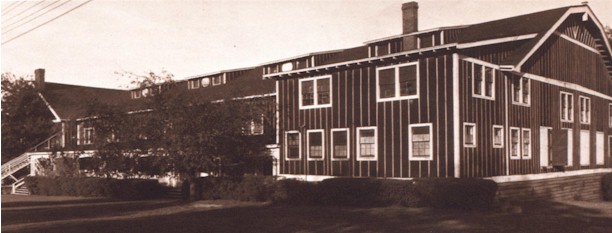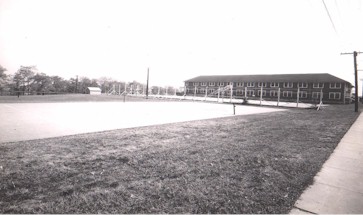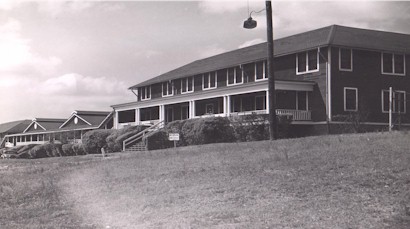|
||||||
 |
||||||
| Until it burned in the early 1940s, this building served not only as a gymnasium for plant league basketball but as a site for parties, dances and even plays presented by plant people. The upper portion used to quarter out-of-town plant visitors, and was known as the "Executive Club." The building was best known for its basketball, though, and games included annual visits by the old New York Celtics to meet Du Pont squads whose members included "Bulldog" Evans, "Chin" Johnson and "Duck" Roberts. Despite the many talents of the locals, the Celtics "usually beat the tar out of us," admitted one plant veteran. "50 Years - Old Hickory Site" | ||||||
| Looking after the Bachelor | ||||||
| There are in Old Hickory many
unmarried male employees whose positions warrant their receiving from
the Company consideration as to their living conditions. Married
men in parallel positions are furnished comfortable houses at moderate
rents but the single men are left to shift for themselves. As a
consequence most of them obtain rooms with private families which is not
satisfactory as the houses are poorly adapted for roomers. These
men also have trouble in obtaining proper meals. Breakfasts and
lunches can be obtained at the Plant Cafeteria but for dinner the men
need a type of meal the Cafeteria does not furnish and there is
practically no place in Old Hickory where such can be obtained. It
is doubtful if a restaurant, of the type needed for these men, run as a
private enterprise would pay on account of the limited patronage it
would obtain.
Another class of men for whom there are poor accommodations is those visiting Old Hickory from other Plants and Offices. There are some of these visitors there practically all of the time, some for a few days only, others for several weeks at a time. At present these visitors are accommodated at the so-called Executive Club. This consists of five or six rooms having two beds each with necessary bath and toilet rooms (not private) and a Lobby. These are located on the second floor over the Lobby of the old Y.W.C.A. building. This layout is satisfactory if one feels he is camping but does not provide comfortable living quarters. Men occupying these rooms have the same trouble obtaining meals as the single men mentioned above. To provide suitable quarters for the men mentioned in the previous paragraphs, it is recommended that a club house or dormitory be erected with ample room to accommodate thirty men. This building should include the necessary kitchen and dining room to provide meals for all occupants. There is an ideal site for such a building on the knoll north of the intersection of Riverside Road and Eighth Street. note: There were 17 lodges for bachelors in 1918. |
||||||
|
|
||||||
|
|
||||||
| Views of Dormitories - bottom photo referred to as girls and boys dorms as well as the Old Hickory Hotel. | ||||||
| A Woman's Life in 1918 | ||||||
| Source: Unknown - Time Frame ~ 1918 | ||||||
| Nineteen dormitories are open here at
the present time. These residences, each two story, accommodate
2400 girls. Five of the buildings are halls. They are named,
Wilson, in honor of President Wilson; Rye in honor of Governor Rye; Foch,
for General Foch, Haig, for General Haig and Hoover, for Herbert Hoover.
Each building has its house club, home spirit and home amusements. It requires nineteen head matrons; as many assistants and seven relief matrons to supervise the residences. Each matron is given a day off each week. Miss Edith Moyer is assistant matron to Miss E. L. Dean, chief over the dormitories and all the employed help. There are two maids, one of the lower and one for the upper floor of each building. _____ The change house has a kitchette designed so that girls may prepare warm coffee to go with their meals. They bring their lunches and eat on the long tables provided in the reception halls. From where we went into the box factory, seated in large airy rooms, hundred of men and women bent over their tasks. This was the first division in the area to employ women. The experiment has proved a success and it seems that they are gradually replacing men as rapidly as women can be trained for the places. Women were first put to work in the operation of machines which do the first work on the box, the nailing of cleats across the top and bottom and shaping of the zinc lining across the top and bottom. The work is light. The larger boxes each have a capacity of 150 pounds of powder. They are zinc lined and air and water tight. If an inspector finds a hole as large as a pin hole, he sends it back to the operator and has it repaired or torn down and rebuilt. Then, there is the small sample box which has a capacity of twenty-five pounds and is used for the purpose of sending firing samples with each order. When running full capacity, the factory puts out, 7,200 boxes per day. Orders for 60,000 boxes have been received this month. The factory opened for the first shift August 6. The second shift went to work, August 20 and the third, September 16. The factory is under the supervision of H.P. Meredith, superintendent of the Mechanical division.
|



